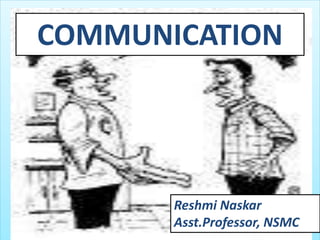
COMMUNICATING EFFECTIVELY
- 2. WHAT IS COMMUNICATION ???
- 3. Communication is the process by which two or more people exchange ideas ,facts, feelings, information to reach to a mutual understanding about a topic or problem of mutual importance. The term communication is derived form the Latin word ‘COMMUNIS’ which means common or community for good reason.
- 4. “Communication is what receiver understands and not what the sender says”
- 5. ‘Communication is the transfer of information and understanding from one person to another.It is the way of reaching others with facts ,ideas, thoughts and values –Keith Davis ‘Communication is any behaviour that results in an exchange of meaning” – American Management Association. Effective Communication is a purposive symbolic interchange resulting in a workable understanding agreement between the sender and the receiver.” – George T. Vardaman. The process by which information is passed between people by means of previously agreed symbols in order to produce a desired response. –Peter Little The process by which an idea is transferred from a source to a receiver with the intention of changing his or her behavior –Rogers and Rogers Communication is a process of sending meaningful messages from one person to another .The messages could be oral , written, visual or olfactory. It is a process which increases commonality but also requires elements of commonality to occur. –Dennis Mac Quail
- 6. It is a process in which participants share information with one another in order to reach mutual understanding about a topic or problem of mutual importance. –D.Lawrence Kincaid Communication arises out of the need to reduce uncertainty ,to act effectively, to defend, or strengthen the ego…communication ceases when meaning are adequate ,it is initiated as soon as new meanings are required –D.C.Barnland It includes all procedures by which one mind may affect another. This of course involves not only written and oral speech ,but also music , pictorial marts , the theatre ,the ballet and infact all human behavior. – Shannon and Warren Weaver. A mechanism by which human relations exist and develop and the symbols of mind together with means of conveying them through space and preserving them in time –Charles Cooley.
- 8. Origin of Communication can be traced back to the origin of civilization Non verbal communication –signs,symbols,grunts Verbal form of communication-Spoken form Written communication –Symbols, drawings Print communication (1820)
- 9. Electronic form of communication –Radio(1930) Television (1959) Digitalization of Communication Tools(1995)
- 11. Sender Encoding Message/Media Decoding Feedback Response Receiver
- 13. TYPES Verbal Non -Verbal 1.Verbal Communication – Communication through words of mouth. 2.Non –verbal communication - Communication through non verbal messages.
- 15. DEFINATION –Communication involving all non verbal stimuli in a communication setting generated by an individual and individual’s use of the environment. Non Verbal Communication – 1.Repeats what was said verbally 2.Compliments what was said verbally 3.Contradicts what was said verbally 4.Substitutes for what would be said verbally 5.Regulates and Manages the communication event.
- 16. 1.general appearance and dress TYPES OF NON VERBAL COMMUNICATION
- 17. TYPES OF NON VERBAL COMMUNICATION 2.Body Movements
- 18. TYPES OF NON VERBAL COMMUNICATION 3.FACIAL EXPRESSIONS
- 19. TYPES OF NON VERBAL COMMUNICATION 4.Eye Contact and Gaze
- 20. TOUCHTYPES OF NON VERBAL COMMUNICATION
- 21. TYPES OF NON VERBAL COMMUNICATION 5.SMELL
- 22. 6.SilenceTYPES OF NON VERBAL COMMUNICATION
- 23. 7.Space and Distance -Proxemics TYPES OF NON VERBAL COMMUNICATION
- 24. a.INTRAPERSONAL COMMUNICATION Holding communication with oneself Individual is a self contained communication system. Constituted of thought processing , information processing and internal dialogue. Basis of all other forms of communication. Enables one to make decisions based on information's received
- 25. INTERPERSONAL COMMUNICATION Face to face communication Communication between two persons Often referred to as dyadic communication. Most used format of communication Mostly includes informal,everyday exchanges between two people. People involved in the process are in close proximity while sending and receiving messages. Characterized by feedback(verbal or non verbal)
- 26. GROUP COMMUNICATION It occurs between three or more persons who perceive themselves as belonging to , or being identified with a group. Interaction and intimacy depends upon the size of the group. The larger the group the less personal and intimate is the possibility of exchange Types – 1.Primary Groups –basic social unit i.e. family 2.Casual or social group –company of adult friends , neighbourhoods and others with whom we socialize. 3.Learning or educational groups – seminars,conferences 4.Work Groups –members have specific goals to be achieved by virtue of employment in an organization.
- 27. PUBLIC COMMUNICATION Involves the sending of messages to a large group of people in a face to face setting Public speaking is the primary tool for this type of participation. The following are the characteristic feature : Lack of verbal exchange between speaker and audience Large groups Less personal Usage of general language Formal approach to communication. Usually occurs in public rather than private places
- 28. MASS COMMUNICATION It is a process of delivering information , ideas attitudes to a sizeable and diversified audience through use of media developed for that purpose. Also known as mediated communication. MASS COMMUNICATION MASS COMMUNICATION (Large cross section of population)
- 29. Characteristics of Mass Communication Large, Heterogeneous , Anonymous audience Mass Medium Impersonal Communication Gatekeeper Delayed Feedback
- 30. Surveillance(Information) ,transmission of cultural heritage , correlation of different parts of society (Herald Lasswell) Entertainment –(Wright,1960) Interpret ,Connect and provide direction to an interaction Provide reward, relaxation and reduction of tension. Mobilize the opinion of people Advance National Interests and promote certain key values and behavioral patterns. Help in reaching decisions Safeguarding of civil liberties .
- 31. 1.Credibility of the communicator 2.Context of communication 3.Content of Communication 4.Clarity 5.Continuty and Consistency 6.Channel 7.Capability of Audience